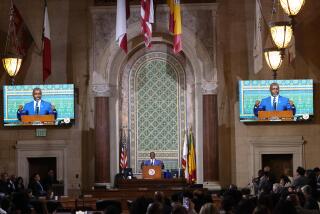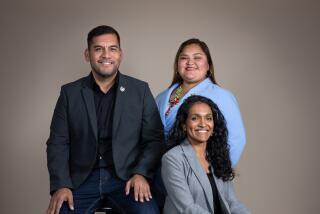A Slower Growing San Clemente and Its City Manager Will Part
- Share via
When James B. Hendrickson was hired as San Clemente’s new city manager 4 years ago, he says, the City Council was dominated by pro-growth members whose wishes he tried to carry out.
But San Clemente’s slow-growth movement began soon after Hendrickson arrived, and some of the council members who had hired him were voted out of office, leaving the city manager to face a new council oriented to slow growth.
Hendrickson said he finally saw the handwriting on the wall 2 weeks ago, when he attended a 2-day retreat and realized that all five council members had been elected after he was hired in December, 1984.
The two newest members, Candace Haggard and Scott Diehl, were elected Nov. 8 to replace two incumbents who did not seek reelection. Three other council members involved in his hiring were defeated in the 1986 election.
So Hendrickson said he and the council made a joint decision: to part company as amicably as possible.
“It is time that I move on to new challenges,” Hendrickson, 44, said in a statement released Friday announcing his resignation from the $88,500-a-year job.
Hendrickson said Monday that he agreed to stay on until June 30 so that the council can have time to pick a successor to run the city of 37,500 residents. However, he said he reserves the right to give 30 days’ notice and depart if he finds another city manager’s job before then.
No Pressure to Resign
Mayor Brian J. Rice said Monday that the city expects to screen “80 to 110” applicants for the job and that a committee will be organized soon to begin the interview process. The city manager supervises 250 full-time employees and a budget of about $30 million.
Hendrickson was not pressured to resign, both he and the mayor said.
“He just had a new ballpark in town” because of the new council, Rice said.
Rice, a staunch slow-growth advocate, insisted that the slow-growth movement had no effect on Hendrickson’s status as city manager. He said the council was seeking someone with a “more innovative” management style than Hendrickson. Rice explained that Hendrickson is a follower of council ideas, not a leader with new ideas--as the council wants.
“We want someone who can give us solutions,” Rice said.
But some city observers insisted that growth--and Hendrickson’s role in it--was, in fact, an overriding issue that led to his resignation. Former Councilwoman Carolyn Koester explained that while Hendrickson was hired by a pro-growth council, the political climate quickly swung to slow growth and he was left to carry on with a pro-growth label.
That label may have been unfair, she said, because Hendrickson inherited from his predecessors a massive residential project in undeveloped hills behind San Clemente that sparked city voters in 1986 to pass Measure B, an initiative limiting new residential growth to 500 units per year.
Hendrickson agreed that he may have been blamed unfairly for allowing new development. He pointed out that when he assumed office in December, 1984, the Rancho San Clemente residential development that drew so much protest had already been approved and was in the construction stage.
“Homes did not materialize until I was sitting in the city manager’s office,” Hendrickson said.
The local slow-growth movement continued to gain momentum during Hendrickson’s tenure. Last June, San Clemente voters passed Measure E, a slow-growth initiative that placed limits on commercial and industrial growth. A developer sued, and an Orange County Superior Court judge tossed out the initiative as unconstitutional.
Undaunted, the new San Clemente council has since appointed a nine-member committee to draft a set of recommendations on how to manage growth, which would be included in the city’s General Plan. Hendrickson’s replacement will oversee that task.
More to Read
Sign up for Essential California
The most important California stories and recommendations in your inbox every morning.
You may occasionally receive promotional content from the Los Angeles Times.













